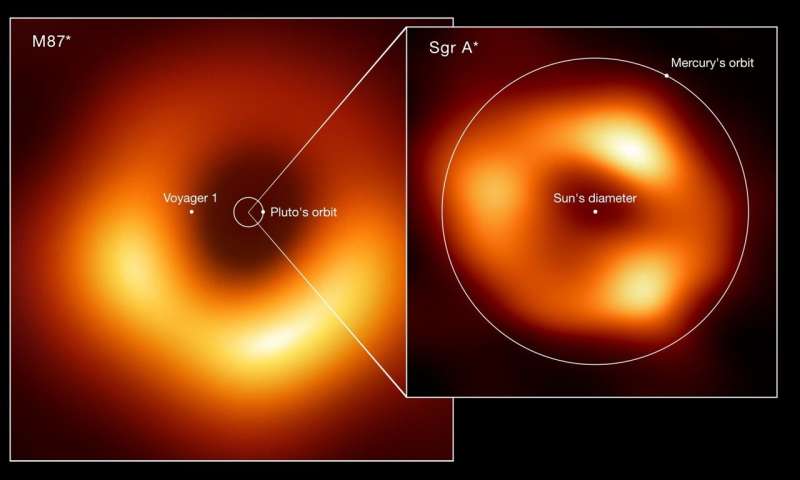This article has been reviewed according to Science X's editorial process and policies. Editors have highlighted the following attributes while ensuring the content's credibility:
fact-checked
preprint
trusted source
proofread
Does the Milky Way's supermassive black hole have a companion?

At the heart of our galaxy, there is a monster black hole. Known as Sagittarius A*, it has a mass of 4.2 million suns, and it's only about 27,000 light-years from Earth. Sag A* is the closest supermassive black hole, and one of only two that we've observed directly. It is so close that we can even see stars closely orbiting it. Some of those stars we've been observing for more than 20 years, which means we have a very good handle on their orbits. We've used those orbits to determine the mass of Sag A*, but a new study looks at a different question: does our galaxy's black hole have a companion?
Most galaxies contain a supermassive black hole, and some galaxies contain two. This is caused by galactic mergers, where the black hole of one galaxy is captured by another. We know from observations that our galaxy doesn't have two supermassive black holes. There could be stellar mass black holes orbiting Sag A*, but current observations wouldn't be sensitive enough to detect them. Another possibility is that there is an intermediate black hole orbiting Sag A*, which is the focus of this work.
An intermediate mass black hole (IMBH) is one with a mass between hundreds and thousands of suns. They aren't formed by the collapse of a massive star, nor are they the gravitational seeds of galaxies. They've only recently been discovered through the gravitational waves of black hole mergers, so they aren't well understood. We don't even know how common they might be. But if an IMBH orbits Sag A*, its gravitational pull would affect the orbits of nearby stars also orbiting our supermassive black hole.
In this study, available on the preprint server arXiv, the team looked at the orbit of a star known as S0-2, or S2. It has one of the closest orbits to Sag A*, with an orbital period of just 16 years. It orbits the black hole so closely that you need to take general relativity into account when calculating its orbit, and we have more than two decades of observational data on it. If there is an IMBH orbiting nearby, S0-2 should be affected by it.
The team found that to the limits of observation, there was no evidence of gravitational perturbations on the orbit of S0-2. This doesn't mean there isn't an intermediate-mass black hole in the area, but it does put some upper bounds on the mass if it does exist. Based on the data, if a hypothetical IMBH orbits outside the orbit of S0-2, say with an orbital radius between 1,000 AU and 4,000 AU, then it could have a mass no greater than 1,000 to 10,000 suns. If there is an IMBH orbiting Sag A* closer than S0-2, then it can have a mass no greater than 400 suns.
Those aren't tight constraints, but they do confirm that there isn't a large intermediate black hole orbiting Sagittarius A*. If it has a smaller IMBH companion, it's currently beyond our ability to detect.
More information: Clifford M. Will et al, Constraining a companion of the galactic center black hole, Sgr A*, arXiv (2023). DOI: 10.48550/arxiv.2307.16646
Journal information: arXiv
Provided by Universe Today




















